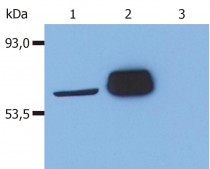ARG63058
anti-Lck antibody [LCK-01]
anti-Lck antibody [LCK-01] for CyTOF®-candidate,Flow cytometry,ICC/IF,Immunoprecipitation,Western blot and Human
Immune System antibody; Signaling Transduction antibody; Src Family Protein Tyrosine Kinases antibody
Overview
| Product Description | Mouse Monoclonal antibody [LCK-01] recognizes Lck |
|---|---|
| Tested Reactivity | Hu |
| Species Does Not React With | Ms |
| Tested Application | CyTOF®-candidate, FACS, ICC/IF, IP, WB |
| Specificity | The clone LCK-01 recognizes defined epitope (aa 22-36) of Lck, a 56 kDa Src-family protein tyrosine kinase. |
| Host | Mouse |
| Clonality | Monoclonal |
| Clone | LCK-01 |
| Isotype | IgG1 |
| Target Name | Lck |
| Antigen Species | Human |
| Immunogen | Peptide corresponding to amino acids 22-36 in the sequence of human Lck. |
| Conjugation | Un-conjugated |
| Alternate Names | T cell-specific protein-tyrosine kinase; Leukocyte C-terminal Src kinase; Protein YT16; p56-LCK; LSK; Proto-oncogene Lck; p56lck; pp58lck; Tyrosine-protein kinase Lck; YT16; IMD22; Lymphocyte cell-specific protein-tyrosine kinase; EC 2.7.10.2 |
Application Instructions
| Application Suggestion |
|
||||||||||||
|---|---|---|---|---|---|---|---|---|---|---|---|---|---|
| Application Note | * The dilutions indicate recommended starting dilutions and the optimal dilutions or concentrations should be determined by the scientist. |
Properties
| Form | Liquid |
|---|---|
| Purification | Purified from ascites by protein-A affinity chromatography. |
| Purity | > 95% (by SDS-PAGE) |
| Buffer | PBS (pH 7.4) and 15 mM Sodium azide |
| Preservative | 15 mM Sodium azide |
| Concentration | 1 mg/ml |
| Storage Instruction | For continuous use, store undiluted antibody at 2-8°C for up to a week. For long-term storage, aliquot and store at -20°C or below. Storage in frost free freezers is not recommended. Avoid repeated freeze/thaw cycles. Suggest spin the vial prior to opening. The antibody solution should be gently mixed before use. |
| Note | For laboratory research only, not for drug, diagnostic or other use. |
Bioinformation
| Database Links | |
|---|---|
| Gene Symbol | LCK |
| Gene Full Name | LCK proto-oncogene, Src family tyrosine kinase |
| Background | Lck is a Src-family tyrosine kinase, which is essential for signaling through the T-cell receptor (TCR) complex. Upon TCR triggering, Lck phosphorylates the ITAM motives in its zeta subunits, establishing binding sites for the SH2 domains of the tyrosine kinase ZAP70, which is also phosphorylated by Lck and thereby activated to generate subsequent signaling platforms by phosphorylation of adaptor LAT. Whereas the majority of Lck is localized to the plasma membrane, there is also a significant fraction associated with the Golgi apparatus, which may contribute to Raf activation under conditions of weak stimulation through the TCR. Lck is also involved in the regulation of apoptosis induced by various stimuli, but not by the death receptors. |
| Function | Non-receptor tyrosine-protein kinase that plays an essential role in the selection and maturation of developing T-cells in the thymus and in the function of mature T-cells. Plays a key role in T-cell antigen receptor (TCR)-linked signal transduction pathways. Constitutively associated with the cytoplasmic portions of the CD4 and CD8 surface receptors. Association of the TCR with a peptide antigen-bound MHC complex facilitates the interaction of CD4 and CD8 with MHC class II and class I molecules, respectively, thereby recruiting the associated LCK protein to the vicinity of the TCR/CD3 complex. LCK then phosphorylates tyrosines residues within the immunoreceptor tyrosine-based activation motifs (ITAM) of the cytoplasmic tails of the TCR-gamma chains and CD3 subunits, initiating the TCR/CD3 signaling pathway. Once stimulated, the TCR recruits the tyrosine kinase ZAP70, that becomes phosphorylated and activated by LCK. Following this, a large number of signaling molecules are recruited, ultimately leading to lymphokine production. LCK also contributes to signaling by other receptor molecules. Associates directly with the cytoplasmic tail of CD2, which leads to hyperphosphorylation and activation of LCK. Also plays a role in the IL2 receptor-linked signaling pathway that controls the T-cell proliferative response. Binding of IL2 to its receptor results in increased activity of LCK. Is expressed at all stages of thymocyte development and is required for the regulation of maturation events that are governed by both pre-TCR and mature alpha beta TCR. Phosphorylates other substrates including RUNX3, PTK2B/PYK2, the microtubule-associated protein MAPT, RHOH or TYROBP. [UniProt] |
| Highlight | Related Antibody Duos and Panels: ARG30169 Src Family Protein Tyrosine Kinases Antibody Panel Related products: Lck antibodies; Lck Duos / Panels; Anti-Mouse IgG secondary antibodies; Related news: CyTOF-candidate Antibodies |
| Research Area | Immune System antibody; Signaling Transduction antibody; Src Family Protein Tyrosine Kinases antibody |
| Calculated MW | 58 kDa |
| PTM | Autophosphorylated on Tyr-394, increasing enzymatic activity, this site is dephosphorylated by PTN22. Phosphorylated on Tyr-505 by CSK, decreasing activity. Dephosphorylated by PTPRC/CD45. Dephosphorylation at Tyr-394 by PTPN2 negatively regulates T-cell receptor signaling. Myristoylation is required prior to palmitoylation. Palmitoylation regulates subcellular location. |
Images (1) Click the Picture to Zoom In








